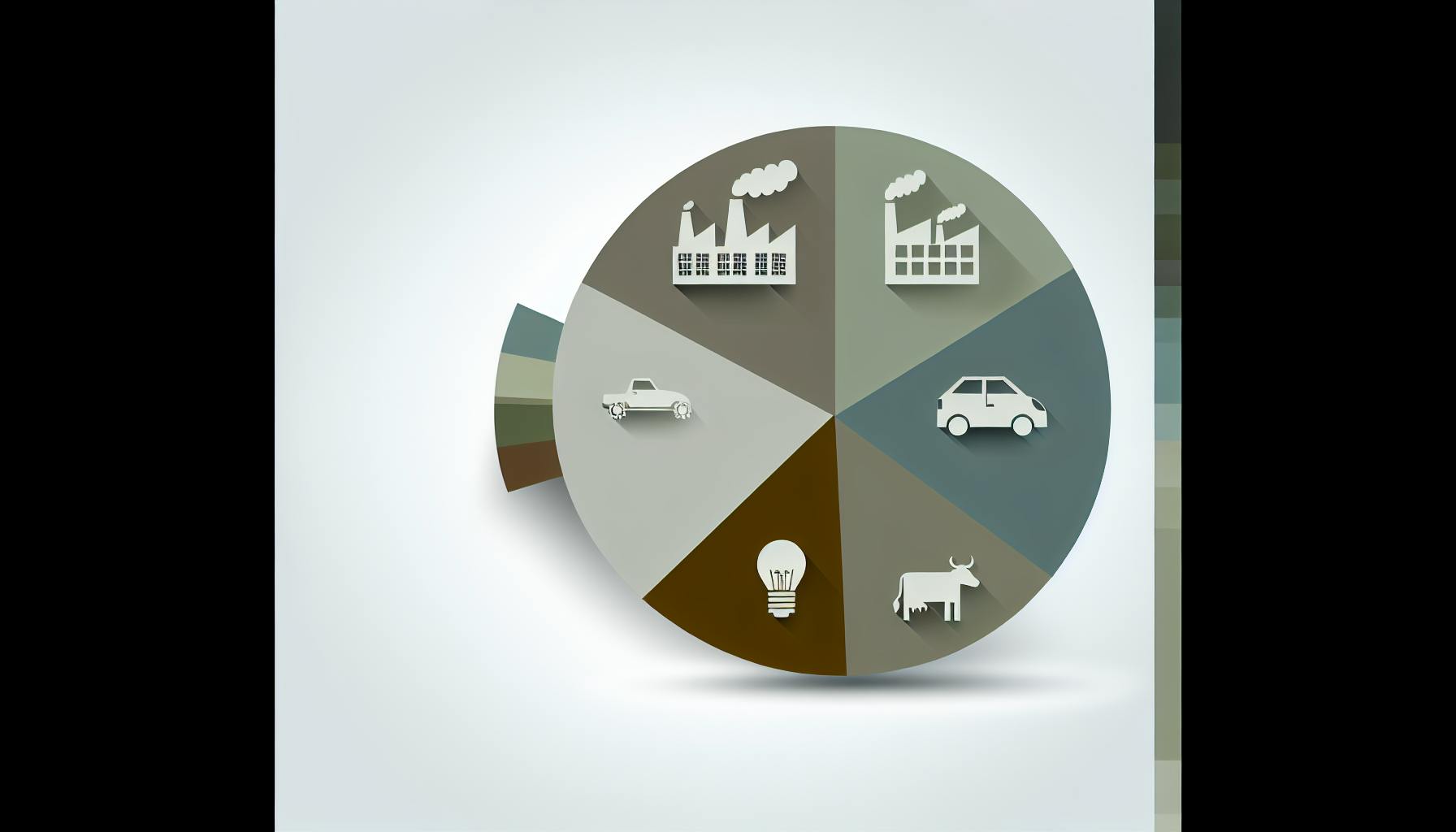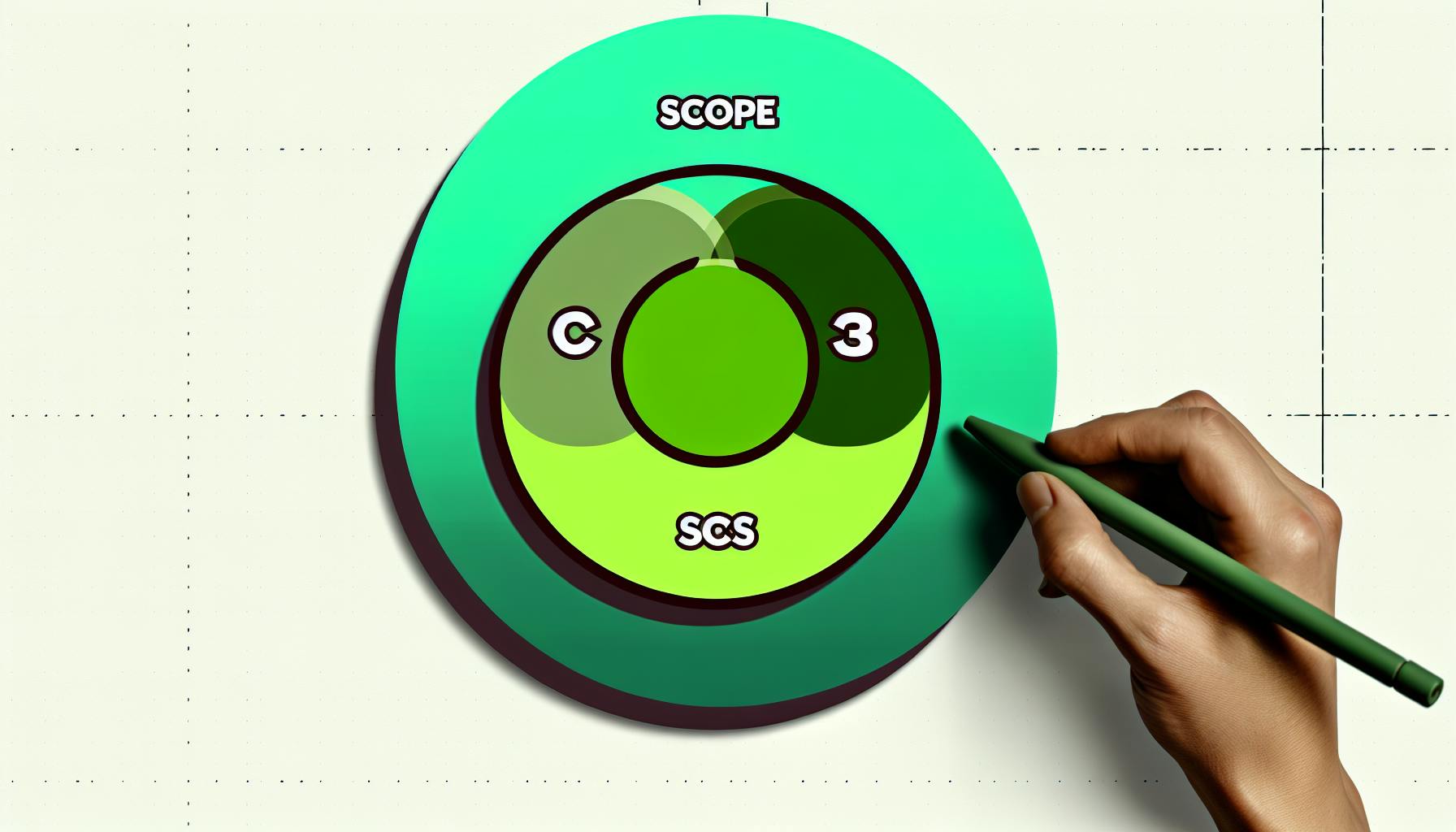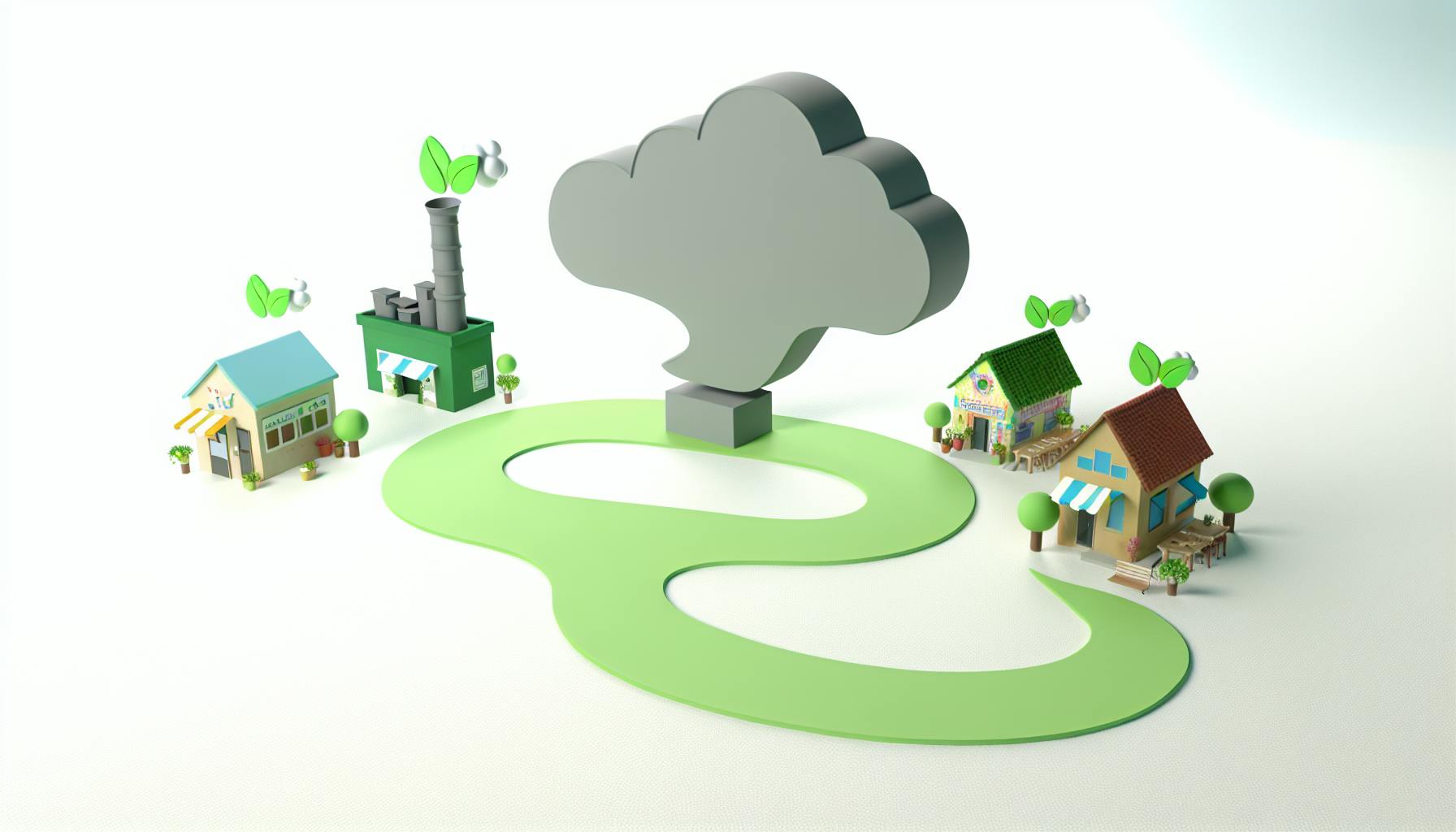As an SME looking to understand emissions reporting, you likely agree that grasping the basics of the GHG Protocol's scopes framework is an essential first step.
By learning the fundamentals of Scope 1, 2, and 3 emissions, you will gain clarity on emissions accounting, enabling smarter strategies for measurement and reduction.
In this introductory guide, you will receive a breakdown of each scope, including practical examples, best practices for calculation and monitoring, and advice for leveraging the GHG Protocol to benchmark progress.
Deciphering Scope 1, 2, and 3 Emissions According to the GHG Protocol
Accurately measuring and reporting greenhouse gas (GHG) emissions is becoming increasingly important for businesses of all sizes. The Greenhouse Gas (GHG) Protocol provides a standardized framework for calculating emissions, making it easier to understand carbon footprints. This guide will explain the basics of Scope 1, 2, and 3 emissions as defined by the GHG Protocol.
The GHG Protocol Explained: Scope 1, 2, & 3 Emissions
The GHG Protocol separates emissions into three categories based on the level of control an organization has over those emissions:
- Scope 1 emissions come directly from sources owned or controlled by the company, like fuel combustion in company vehicles or gas used in heating buildings. For example, a delivery service would include emissions from its fleet in its Scope 1 footprint.
- Scope 2 covers indirect emissions from purchased electricity used in company buildings and operations. While the company itself does not directly emit these GHGs, it indirectly causes them through its energy choices.
- Scope 3 emissions represent all other indirect emissions across the wider value chain, both upstream and downstream. This includes emissions from raw materials, transportation, waste disposal, investments, and more. For example, an apparel company's Scope 3 emissions would incorporate impacts from cotton farming and customer laundry.
Accurately measuring Scope 1 and 2 emissions provides a baseline, while including Scope 3 offers a comprehensive view of the full business carbon footprint.
Why GHG Protocol Is Essential for Emissions Reporting
The GHG Protocol provides consistency, credibility, and benchmarking around emissions measurement. By conforming to an internationally recognized standard, companies can:
- Simplify and streamline carbon accounting through clear methodological guidance, calculation tools, and reporting templates. This makes the process more accessible, especially for small and medium enterprises (SMEs).
- Demonstrate credibility to customers and stakeholders by following accepted best practices for emissions calculations and disclosures.
- Compare and contextualize footprints by benchmarking against industry standards and peer companies also using the GHG Protocol.
Adhering to this global standard ensures emissions get measured systematically across all three scopes using consistent boundary setting, data collection processes, and transparency expectations.
Methods for Emissions Calculation Across All Scopes
While simple in principle, accurately calculating GHG emissions can prove challenging in practice. The GHG Protocol provides flexibility to estimate footprints with different levels of detail using two main approaches:
- A calculation-based methodology directly measures activity data, like fuel usage or kilowatt-hours of electricity, and calculates emissions using published emissions factors. This bottom-up approach provides greater accuracy.
- A measurement-based methodology directly measures atmospheric concentrations of GHGs to determine whole-facility or organization-wide emissions. This top-down approach is simpler but depends heavily on estimation.
Hybrid methods combine elements of both approaches. As SMEs begin their sustainability journey, some initial estimation is reasonable to establish a baseline to improve on over time by refining calculations with better data and assessment boundaries.
What is the scope 2 emissions GHG Protocol?
The GHG Protocol published Scope 2 Guidance that standardizes how corporations measure emissions from purchased or acquired electricity, steam, heat, and cooling. Many industrial sectors also have process-related emissions sources specific to their industry.
Scope 2 covers indirect GHG emissions from the generation of purchased or acquired electricity, steam, heat, or cooling consumed by a company. It allows companies to account for greenhouse gas emissions that occur at facilities they do not own or control.
Some examples of Scope 2 emissions sources are:
- Electricity purchased and consumed from the grid
- Heating or cooling consumption acquired from district heating/cooling facilities
- Steam purchased from district energy facilities
By measuring Scope 2 emissions, companies take responsibility for emissions associated with their energy consumption even though they do not control the energy generation sources. Understanding Scope 2 emissions is key for companies buying renewable energy or implementing energy efficiency projects.
The GHG Protocol Scope 2 guidance provides consistency for businesses in calculating energy-related emissions, aiding performance tracking and benchmarking over time. It enables meaningful comparisons of emissions performance across companies and transparency for external stakeholders.
Adopting the Scope 2 guidance allows companies to showcase efforts towards decarbonization by transitioning energy consumption to renewable sources. This drives climate action through procurement policies favoring clean energy.
What is the GHG Protocol emissions?
The GHG Protocol establishes comprehensive global frameworks for organizations to measure and manage their greenhouse gas (GHG) emissions.
The key frameworks consist of:
- Scope 1 emissions - Direct emissions from owned or controlled sources. Examples include emissions from fuel combustion in boilers or vehicles.
- Scope 2 emissions - Indirect emissions from the generation of purchased energy. An example is purchasing electricity generated from fossil fuels.
- Scope 3 emissions - All indirect emissions not covered in Scope 2. Examples include purchased goods, business travel, waste disposal, etc.
Understanding the differences between Scope 1, 2, and 3 emissions is crucial for organizations aiming to accurately measure and report their carbon footprint as per the GHG Protocol methodology. Most carbon accounting software solutions, including EcoHedge's products, align with the GHG Protocol by enabling companies to track emissions across the three scopes.
Adopting the GHG Protocol allows businesses to:
- Identify the largest sources of emissions across their operations and value chain
- Set emission reduction targets in line with climate science
- Benchmark performance against industry peers
- Meet emerging disclosure requirements from regulators and investors
By providing clear guidance on emissions measurement, the GHG Protocol empowers organizations on their journey towards net-zero emissions. Integrating a purpose-built software solution like EcoHedge further simplifies the process of carbon accounting as per the protocol.
What are the 5 principles of GHG Protocol?
The GHG Protocol outlines 5 key principles for companies to follow when measuring and reporting their greenhouse gas emissions:
Relevance
Focus your emissions inventory on the sources that are most relevant and significant to your business's climate impact. Prioritize measuring Scope 1 and 2 emissions first.
Completeness
Account for all emission sources and activities within the inventory boundary you set. Disclose and justify any exclusions.
Consistency
Use consistent methodologies and emission factors year-over-year. Document any changes to allow for meaningful comparisons of emissions over time.
Transparency
Address all relevant issues in a factual and coherent manner, keeping inventory methodologies and assumptions open, clear and accessible.
Accuracy
Ensure the quantification of emissions is systematically neither over nor under actual emissions, as far as can be judged. Achieve sufficient accuracy to enable users to make decisions with reasonable confidence.
Following these principles helps companies compile carbon inventories that genuinely reflect their emissions profile. By providing complete, consistent and transparent emissions data, the GHG Protocol methodology builds trust and accountability into sustainability reporting.
What are the 7 gases in GHG Protocol?
The GHG Protocol tracks emissions across seven major greenhouse gases that contribute to climate change:
- Carbon dioxide (CO2)
- Methane (CH4)
- Nitrous oxide (N2O)
- Hydrofluorocarbons (HFCs)
- Perfluorocarbons (PFCs)
- Sulphur hexafluoride (SF6)
- Nitrogen trifluoride (NF3)
These gases have different global warming potentials and atmospheric lifetimes, but together make up the total greenhouse gas inventory that companies track and report.
Understanding the composition of emissions helps businesses identify the largest sources and best opportunities to reduce their climate impact. For example, methane and HFCs have much higher warming effects than carbon dioxide, so cutting those gases can lead to faster reductions.
sbb-itb-0f1f828
Delving into Scope 1 Emissions: Direct Impact and Control
Scope 1 emissions refer to direct greenhouse gas (GHG) emissions that occur from sources owned or controlled by a company. These emissions have a direct impact on a company's carbon footprint as they originate from operations within their business boundary.
Some examples of Scope 1 emission sources typical for small and medium enterprises include:
Scope 1 Emissions Examples: On-Site Activities
- Fleet vehicles owned by the company
- On-site fuel combustion for heating or power generation
- Fugitive emissions from refrigeration/AC equipment
- Manufacturing processes that release GHGs
- Waste decomposition at landfills owned by the company
Accurately quantifying Scope 1 emissions allows companies to identify major emission hotspots under their control. This enables informed decisions on reduction strategies.
Strategies for Accurate Scope 1 Emissions Measurement
Some recommended practices for measuring Scope 1 emissions include:
- Installing sub-meters on site to directly monitor fuel and energy usage
- Tracking vehicle fuel consumption from fleet vehicle logs
- Conducting leak detection tests for fugitive refrigerants
- Using emissions factors specific to each process/fuel type
Automated carbon accounting software can greatly simplify Scope 1 emissions tracking by seamlessly pulling data from multiple on-site sources.
Establishing Your Scope 1 Emissions Baseline
Determining a Scope 1 emissions baseline provides a reference point to track performance over time. Companies should measure their Scope 1 emissions when they first commit to climate action plans, then compare future emissions against this baseline to evaluate progress. A lower Scope 1 emissions total indicates effective reduction strategies targeting direct emission sources.
Continually refining your Scope 1 emissions inventory and calculations leads to more accurate carbon accounting. This visibility empowers data-driven decisions to achieve sustainability targets.
Understanding Scope 2 Emissions: Energy Indirectness
Scope 2 emissions account for indirect greenhouse gas emissions from the generation of purchased or acquired electricity, steam, heating, and cooling consumed by a company. Unlike Scope 1 emissions which come from sources owned or controlled by the company, Scope 2 emissions physically occur at the facility where energy generation takes place.
Scope 2 Emissions and Their Distinct Characteristics
Scope 2 emissions have some key differences from Scope 1:
- Energy sources - Scope 2 covers purchased electricity, steam, heating, and cooling. Scope 1 involves on-site combustion of fuels.
- Ownership - Scope 2 applies to energy consumed but supplied by external utilities. Scope 1 relates to sources owned/controlled by the company.
- Accounting - Scope 2 emissions are harder to measure and rely on supplier data. Scope 1 can be directly monitored with emission factors.
For SMEs, tracking Scope 2 usage is vital to understand total footprint and identify efficiency opportunities around energy, especially as decarbonization often focuses on electricity first.
Monitoring Scope 2 Energy Use: Tools and Tips
Monitoring Scope 2 energy starts with collecting supplier invoices and meter readings. Some options to track usage include:
- Energy management software - Applications like EcoHedge Express can automatically log usage data from bills.
- Cloud analytics - Leveraging cloud services to consolidate energy spend.
- Smart meters - Internet-connected devices providing granular, real-time consumption data.
Regular monitoring lets SMEs identify trends and anomalies to guide energy efficiency initiatives.
Mitigating Scope 2 Emissions Through Renewable Energy
Procuring renewable energy can minimize Scope 2 emissions instead of standard grid-supplied energy:
- Power purchase agreements (PPAs) - Contracting electricity straight from the renewable generator.
- Renewable Energy Certificates (RECs) - Each REC represents 1 MWh of renewable energy to offset conventional supply.
Adopting renewables via PPAs or RECs helps shrink an SME's overall carbon footprint.
Scope 3 Emissions: Understanding the Extended Impact
Scope 3 emissions refer to indirect greenhouse gas emissions from a company's value chain. Unlike Scope 1 and 2 emissions which come directly from a company's operations, Scope 3 emissions occur as a result of activities from assets not owned or controlled by the company.
For small and medium enterprises (SMEs), while Scope 3 emissions are likely to form a major part of your carbon footprint, calculating and reporting these emissions can be complex. This section provides an introductory guide to help SMEs identify, prioritize and develop a roadmap to reduce the most material Scope 3 emissions sources.
Identifying Key Scope 3 Emissions Sources
The GHG Protocol defines 15 categories of Scope 3 emissions based on typical value chain activities. The most relevant Scope 3 categories for SMEs are usually:
- Purchased goods and services - Emissions from extracting, manufacturing, and transporting goods and services purchased
- Transportation and distribution - Transporting products purchased by end consumers
- Waste generated in operations - Waste disposal and treatment
The specific Scope 3 categories that are largest depend on the sector. For example, for a software company it may be emissions from purchased cloud services, while an ecommerce retailer would focus more on transportation and distribution emissions.
Prioritization of Scope 3 Categories for Effective Management
Since measuring all Scope 3 emissions can be resource intensive, it's recommended for SMEs to focus on measuring and managing emissions from 1-3 categories that are most material, over which you likely have some influence, and for which data is available.
Over time as capabilities improve, SMEs can progressively expand measurement and management to additional Scope 3 categories. Setting a phased target helps make this manageable.
Developing a Scope 3 Reduction Roadmap
Here are some tips when creating a Scope 3 emissions target and action plan:
- Conduct a qualitative assessment to shortlist the most material Scope 3 categories
- Collect activity data and calculate emissions for priority categories
- Set a phased target, starting with 1-2 categories in phase 1
- Identify potential reduction initiatives for priority categories
- Track and report progress over time
- Expand measurement and management to further categories in later phases
With the right roadmap tailored to business objectives, SMEs can effectively tackle Scope 3 emissions and drive value chain decarbonization. Reaching out to suppliers and service providers to collect emissions data and motivate collective climate action is key.
Benchmarking with the GHG Protocol: A Tool for Progress
The Greenhouse Gas (GHG) Protocol provides globally recognized standards for measuring and managing greenhouse gas emissions. For small and medium-sized enterprises (SMEs) looking to benchmark their emissions performance, the GHG Protocol offers useful frameworks to compare against industry averages.
Engaging in CDP: Scope 1, 2, & 3 Emissions Disclosure
The CDP (formerly Carbon Disclosure Project) runs a global disclosure platform for companies, cities, states and regions to report their environmental impacts. Over 13,000 organizations reported through CDP in 2021.
Reporting through CDP provides the following benefits:
- Public demonstration of your commitment to emissions transparency
- Identification of risks and opportunities from climate change
- Benchmarking of your performance against industry peers
- Motivation for internal carbon reduction initiatives
CDP assessments include measuring and disclosing Scope 1, 2 & 3 emissions as categorized under the GHG Protocol. So it can serve as a starting point for SMEs to grasp these emissions reporting basics.
Industry-Specific Benchmarking Using the GHG Protocol
The GHG Protocol offers sector-specific guidance supplements in various industries such as:
- Information & Communications Technology (ICT)
- Transportation
- Oil & Gas
These provide tailored methods to calculate GHG inventories for companies in those industries. By reporting emissions according to the guidance for your sector, SMEs can benchmark against average industry performance.
Committing to Science-Based Targets for Emissions Reduction
Science-based targets (SBTs) indicate how much and how quickly your company aims to reduce emissions to prevent climate change worsening. Over 3,000 businesses have SBTs approved by the Science-Based Targets Initiative (SBTi).
Committing to an SBT sends a strong signal to stakeholders that your SME is dedicated to meaningful decarbonization aligned with climate science. The target is measured against scopes 1, 2 and 3 emissions as categorized by the GHG Protocol.
So the GHG Protocol scopes offer a basis for SMEs to set strategic science-based climate commitments benchmarked to sector averages.
Conclusion: Wrapping Up GHG Protocol Fundamentals
Summarizing the Advantages of the GHG Protocol
The GHG Protocol provides a standardized framework for companies to measure and report their greenhouse gas emissions. Key benefits for SMEs include:
- Credibility and transparency: Following an internationally recognized standard demonstrates commitment to accuracy and accountability. This builds trust with stakeholders.
- Benchmarking opportunities: The consistent methodology allows comparison with industry peers to gauge performance.
- Fulfilling stakeholder needs: Investors, customers, regulators and others often require emissions disclosures aligned with the GHG Protocol.
Starting Points for GHG Emissions Management
For SMEs new to emissions measurement, we recommend these initial steps:
- Become familiar with Scope 1, Scope 2 and Scope 3 emissions definitions.
- Identify your largest sources of emissions and start measuring Scope 1 and 2. Use calculators and industry benchmarks to estimate Scope 3.
- Assemble historical emissions data and set a current year baseline. Track against this over time.
- Consider verification to demonstrate commitment and rigor.
Envisioning a Greener Future Through Emissions Reporting
Once the basics are covered, SMEs can expand their emissions program by:
- Broadening measurement to additional Scope 3 categories.
- Setting science-based reduction targets.
- Engaging suppliers and customers on quantifying and lowering value chain emissions.
Standardized GHG accounting and reporting builds foundations for sustainability progress.



